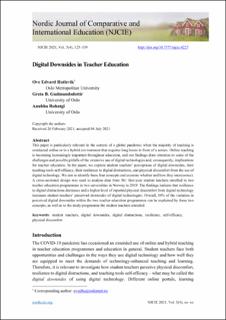Digital downsides in teacher education
Peer reviewed, Journal article
Published version
Permanent lenke
https://hdl.handle.net/11250/2833914Utgivelsesdato
2021-11-30Metadata
Vis full innførselSamlinger
Originalversjon
Nordic Journal of Comparative and International Education (NJCIE). 2021, 5 (4), 123-139. http://doi.org/10.7577/njcie.4227Sammendrag
This paper is particularly relevant in the context of a global pandemic when the majority of teaching is conducted online or in a hybrid environment that requires long hours in front of a screen. Online teaching is becoming increasingly important throughout education, and our findings draw attention to some of the challenges and possible pitfalls of the extensive use of digital technologies and, consequently, implications for teacher education. In the paper, we explore student teachers’ perceptions of digital downsides, their teaching tools self-efficacy, their resilience to digital distractions, and physical discomfort from the use of digital technology. We aim to identify these four concepts and examine whether and how they interconnect. A cross-sectional design was used to analyse data from 561 first-year student teachers enrolled in two teacher education programmes in two universities in Norway in 2019. The findings indicate that resilience to digital distractions decreases and a higher level of reported physical discomfort from digital technology increases student teachers’ perceived downsides of digital technologies. Overall, 38% of the variation in perceived digital downsides within the two teacher education programmes can be explained by these two concepts, as well as to the study programme the student teachers attended.

